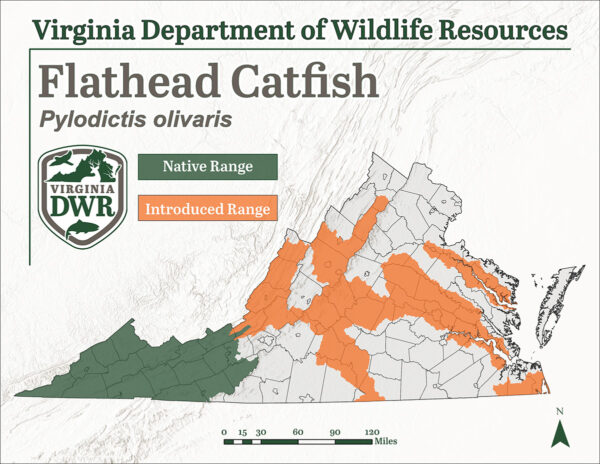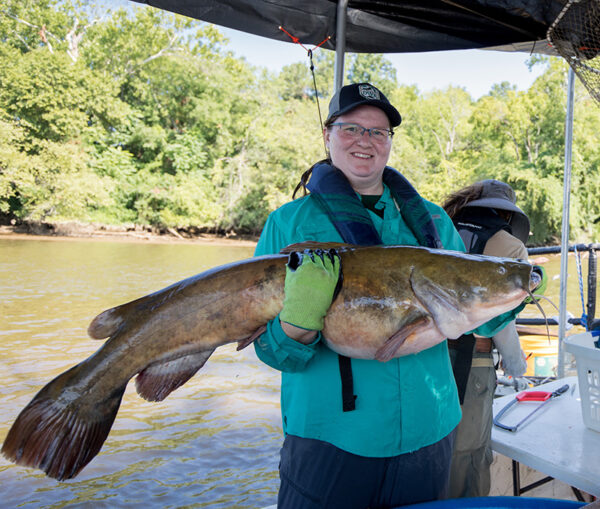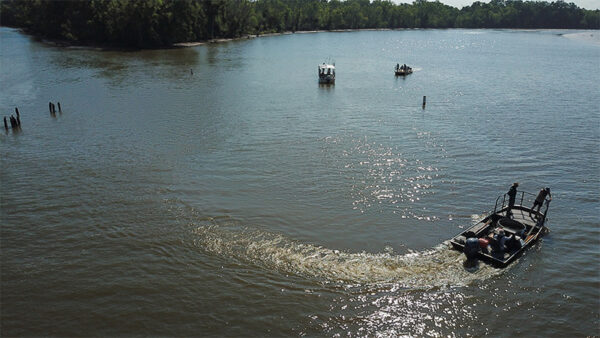A juvenile Flathead Catfish being processed by fisheries biologists during a low-frequency electrofishing survey. ©Meghan Marchetti - DWR
Virginia Master Angler Grant Alvis displays a large Flathead Catfish. ©Grant Alvis
Fact File
Scientific Name: Pylodictis olivaris
Classification: Fish, Order Siluriformes, Family Ictaluridae
Size: Flathead Catfish can surpass 50 inches in length and 60 pounds in weight
Life Span: Flathead Catfish live to an average of 20 years in Virginia
Distribution
The Flathead Catfish is native to the Tennessee, New, and Big Sandy watersheds in Virginia. Its range has expanded elsewhere throughout the state, primarily due to illegal stockings.

Identifying Characteristics

DWR Biologists process a Flathead Catfish during an electrofishing survey. Photo by ©Meghan Marchetti – DWR
- A flat, wide head with a slightly projected lower jaw (underbite).
- Barbels present on the top and corner of the mouth, as well as the lower jaw
- Body color can be brown, olive, or yellow
- Spines are present on the dorsal and pectoral fins
- The caudal fin is minimally notched, and may appear rounded or squared
Ictaluridae Characteristics and Anatomical Terms


Illustrations by ©Makayla DeVivo – DWR
Habitat

Catfish sampling on the James River. Photo by ©Meghan Marchetti – DWR
Flathead Catfish thrive in many of the freshwater rivers and lakes throughout Virginia. Flathead Catfish seek out areas with overhead cover, preferring to occupy water underneath trees, undercut banks, or submerged structure that allow them to ambush unsuspecting prey items. Pilings like those seen in the image above are excellent areas to find Flathead Catfish.
Diet
Flathead Catfish are ambush predators, and primarily feed at night. Juvenile Flathead Catfish primarily consume insects and crayfish, but will transition to a mostly piscivorous diet (other fish) as they mature into adults.
Reproduction
Flathead Catfish spawn between May and July, often creating nests underneath overhanging ledges, logs, or other protected sites.
Flathead Catfish eggs usually develop in about 7 days in Virginia. At this time, they remain hidden while absorbing their yolk sack. Both the male and female will defend the spawning site from unwanted visitors.
Special Considerations
In many locations where the Flathead Catfish has been introduced, it is considered an invasive species. Invasive species disrupt the established ecological dynamics of a given area, and have the potential to negatively impact populations of native species. Anglers are reminded that it is illegal to stock fish into a public body of water without an authorization from the Virginia Department of Wildlife Resources.
Last updated: July 22, 2025
The Virginia Department of Wildlife Resources Species Profile Database serves as a repository of information for Virginia’s fish and wildlife species. The database is managed and curated by the Wildlife Information and Environmental Services (WIES) program. Species profile data, distribution information, and photography is generated by the Virginia Department of Wildlife Resources, State and Federal agencies, Collection Permittees, and other trusted partners. This product is not suitable for legal, engineering, or surveying use. The Virginia Department of Wildlife Resources does not accept responsibility for any missing data, inaccuracies, or other errors which may exist. In accordance with the terms of service for this product, you agree to this disclaimer.

